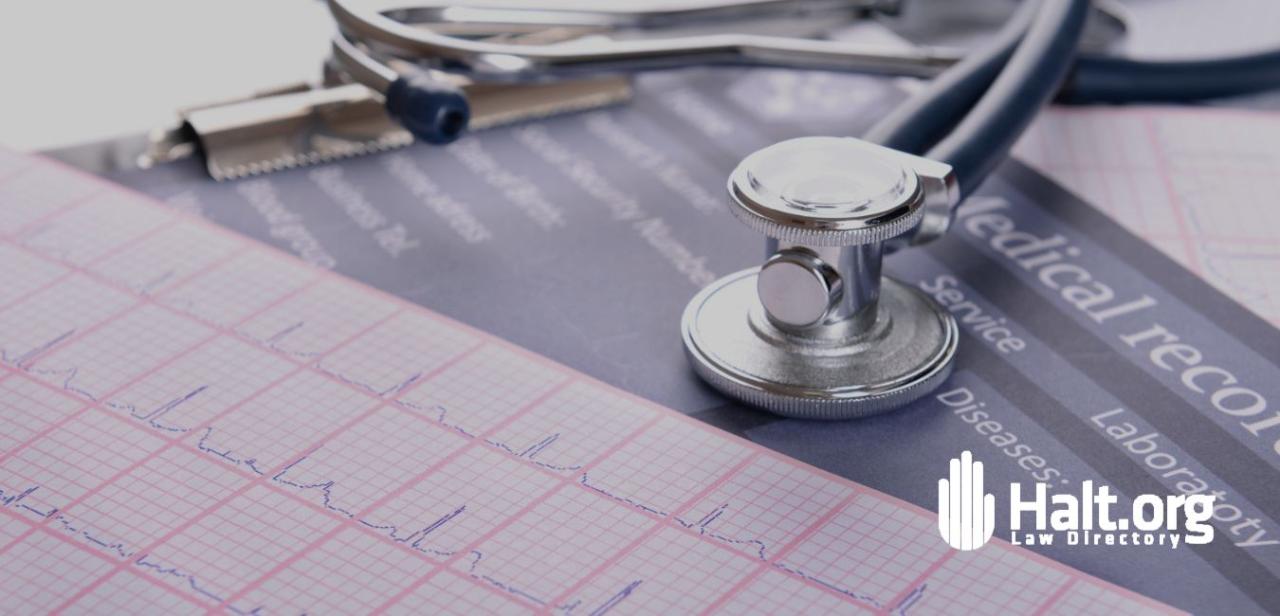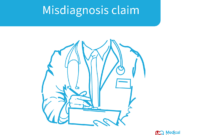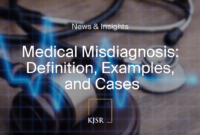Common Misdiagnosis Cases and How Solicitors Can Help: Medical misdiagnosis is a devastating reality, leaving countless individuals facing physical, emotional, and financial distress. The consequences can be life-altering, leading to delayed or inadequate treatment, prolonged suffering, and permanent disability. This often results in a need for legal intervention, where solicitors play a crucial role in navigating the complexities of medical negligence claims. Understanding the common types of misdiagnosis, the legal pathways available, and the challenges involved is vital for both patients and legal professionals.
This guide explores the prevalence of misdiagnosis in various medical fields, detailing the common conditions frequently misdiagnosed and the devastating consequences that follow. We will examine the role of solicitors in representing clients, the process of building a strong case, the challenges in proving negligence, and the factors influencing compensation awards. Through case studies and expert insights, we aim to provide a comprehensive understanding of this critical area of medical law.
Types of Misdiagnosis and Their Consequences

Medical misdiagnosis is a serious issue with potentially devastating consequences for patients. The failure to correctly identify and treat a condition can lead to significant short-term and long-term health problems, impacting quality of life and even resulting in premature death. Understanding the common types of misdiagnosis, their associated symptoms, and the potential legal ramifications is crucial for both patients and legal professionals.
Cancer Misdiagnosis
Cancer misdiagnosis, whether through a delayed diagnosis or a completely incorrect diagnosis, can have catastrophic consequences. A delayed diagnosis allows cancer to progress to more advanced stages, reducing treatment effectiveness and survival rates. Incorrect diagnoses can lead to inappropriate treatment, delaying appropriate care and potentially causing further harm. For example, a misdiagnosis of benign breast lumps as cancerous can lead to unnecessary surgery and emotional distress, while a missed diagnosis of lung cancer can result in irreversible lung damage and metastasis. Short-term consequences can include unnecessary procedures, anxiety, and depression. Long-term consequences range from reduced life expectancy to permanent disability and significant financial burden due to extensive medical treatment.
Heart Condition Misdiagnosis
Misdiagnosis of heart conditions, such as coronary artery disease or heart valve problems, can have equally severe repercussions. Symptoms of heart conditions can be subtle or mimic other illnesses, making accurate diagnosis challenging. A missed diagnosis of a heart attack, for instance, can lead to irreversible heart damage and increased risk of future cardiac events. Similarly, misdiagnosing a heart murmur could delay necessary intervention for a potentially life-threatening condition. Short-term consequences may include unnecessary medication, unnecessary tests, or inadequate treatment for the actual underlying heart condition. Long-term consequences could include heart failure, stroke, or even death.
Neurological Disorder Misdiagnosis
Neurological disorders, including multiple sclerosis (MS), Parkinson’s disease, and Alzheimer’s disease, often present with complex and overlapping symptoms, increasing the likelihood of misdiagnosis. Delaying or incorrectly diagnosing these conditions can significantly impede effective management and limit the opportunities for early intervention therapies. For instance, a misdiagnosis of depression instead of early-stage Alzheimer’s can delay the appropriate care and support for both the patient and their family. Short-term consequences might involve inappropriate medication, leading to adverse effects and hindering the identification of the correct diagnosis. Long-term consequences could include progressive neurological decline, loss of independence, and decreased quality of life.
Misdiagnosis Comparison Table
The following table compares different misdiagnosis types, their symptoms, delayed diagnosis consequences, and potential legal recourse.
| Misdiagnosis Type | Common Symptoms | Delayed Diagnosis Consequences | Potential Legal Recourse |
|---|---|---|---|
| Cancer (e.g., Breast Cancer) | Lumps, pain, changes in skin or nipple, bleeding | Metastasis, reduced treatment effectiveness, decreased survival rate | Medical negligence claim for damages, including medical expenses, lost income, and pain and suffering. |
| Heart Condition (e.g., Myocardial Infarction) | Chest pain, shortness of breath, sweating, nausea | Irreversible heart damage, heart failure, stroke, death | Medical negligence claim for damages, including medical expenses, lost income, and pain and suffering. |
| Neurological Disorder (e.g., Multiple Sclerosis) | Fatigue, numbness, weakness, vision problems, balance issues | Progressive neurological decline, disability, loss of independence | Medical negligence claim for damages, including medical expenses, lost income, and pain and suffering. |
| Infectious Disease (e.g., Meningitis) | Fever, headache, stiff neck, vomiting | Permanent neurological damage, death | Medical negligence claim for damages, including medical expenses, lost income, and pain and suffering. |
The Solicitor’s Role in Medical Negligence Cases: Common Misdiagnosis Cases And How Solicitors Can Help
Solicitors play a crucial role in navigating the complexities of medical negligence cases stemming from misdiagnosis. Their expertise ensures clients receive fair compensation and justice for the harm suffered due to medical errors. They act as advocates, investigators, and strategists, guiding clients through the often-daunting legal process.
Initial Steps in Misdiagnosis Cases
When a client alleges misdiagnosis, the solicitor’s initial steps involve a thorough assessment of the case. This includes reviewing the client’s medical history, obtaining detailed accounts of their experiences, and evaluating the potential for a successful claim. A key element is determining whether the alleged misdiagnosis falls below the accepted standard of care expected from a medical professional. This often requires preliminary discussions with medical experts to gauge the viability of the claim. The solicitor will also advise the client on the potential legal avenues and the likely timeframe for the case.
Gathering Evidence in Medical Negligence Claims
Building a strong case requires meticulous evidence gathering. This begins with obtaining comprehensive medical records from all relevant healthcare providers. These records are meticulously reviewed to identify inconsistencies, missed diagnoses, delayed treatments, or any other evidence supporting the claim of negligence. Crucially, solicitors secure expert medical opinions from specialists in the relevant field. These independent experts assess the medical care provided, comparing it to established best practices. Their reports form the cornerstone of the legal argument, detailing the alleged breaches of duty and their causal link to the client’s harm. Other evidence might include witness statements from family members, friends, or other healthcare professionals involved in the client’s care.
Strategies for Building a Strong Case
Solicitors employ several strategies to build a compelling case. A key element is establishing a clear timeline of events, demonstrating the sequence of medical interactions and the point at which the alleged misdiagnosis occurred. They meticulously connect the alleged negligence to the client’s injuries, proving a direct causal link between the misdiagnosis and the subsequent harm suffered. This may involve demonstrating that timely and accurate diagnosis would have prevented or mitigated the harm. Solicitors also present evidence of the client’s losses, which may include pain and suffering, loss of earnings, and the cost of future medical care. This often involves detailed financial records and expert testimony from economists or rehabilitation specialists. A strong case relies on clear, concise presentation of the evidence, meticulously linking each piece to the overall narrative of negligence and harm. This ensures a persuasive argument that convinces the court or insurer of the validity of the claim.
Building a Case

Successfully prosecuting a medical negligence case hinges on meticulously building a robust case, supported by irrefutable evidence and compelling expert testimony. This process demands a systematic approach, combining thorough investigation with a clear understanding of legal procedures. The ultimate goal is to present a convincing narrative demonstrating a clear breach of duty, causation, and resulting harm.
Expert medical opinions are the cornerstone of any successful medical negligence claim. They provide the crucial link between the alleged negligence and the patient’s injuries. Without expert testimony substantiating the claim, it is highly unlikely that a case will succeed. The court relies heavily on expert witnesses to interpret complex medical information and explain the standard of care expected from medical professionals.
Securing Expert Medical Opinions
The selection of an expert witness is a critical decision. Solicitors must identify a medical professional with the necessary expertise and experience in the relevant area of medicine. The expert’s reputation and credibility are paramount. The solicitor should thoroughly vet the potential expert, reviewing their CV, publications, and previous court testimony to ensure they possess the necessary qualifications and a strong track record. Once an appropriate expert is identified, a detailed brief outlining the case specifics, including medical records and relevant legal arguments, should be provided. The expert will then review the information and provide a written report detailing their opinion on the standard of care, causation, and the extent of the patient’s injuries. This report forms a crucial piece of evidence. For example, in a case involving a delayed cancer diagnosis, an oncologist specializing in the relevant cancer type would be crucial to establishing the standard of care and demonstrating the causal link between the delay and the patient’s worsened prognosis.
Obtaining and Presenting Medical Records in Court, Common Misdiagnosis Cases and How Solicitors Can Help
Medical records constitute the primary evidence in medical negligence cases. They provide a detailed account of the patient’s medical history, diagnosis, treatment, and prognosis. Solicitors must diligently obtain all relevant medical records from hospitals, clinics, and other healthcare providers. This process often involves navigating complex bureaucratic procedures and may require the issuance of formal requests or court orders. Once obtained, the records must be carefully reviewed and organized to identify key pieces of evidence supporting the claim. For instance, inconsistencies in medical notes, missed diagnostic tests, or delayed treatment could all be crucial evidence. In court, these records are presented as exhibits and can be used to corroborate the expert witness testimony and build a comprehensive picture of the case. The solicitor must be prepared to explain the records’ significance and context to the judge and jury.
Presenting Evidence in Court
Effectively presenting evidence requires a structured and methodical approach. A step-by-step guide for solicitors is Artikeld below:
- Preparation: Thoroughly review all evidence, including medical records, expert reports, and witness statements. Organize the evidence logically and chronologically to create a clear and compelling narrative.
- Witness Examination: Prepare detailed questions for both expert witnesses and fact witnesses (e.g., the patient). Focus on eliciting clear, concise, and factual answers that support the claim. Anticipate opposing counsel’s cross-examination and prepare responses.
- Exhibit Presentation: Present exhibits (medical records, photographs, etc.) clearly and systematically, ensuring they are properly identified and authenticated. Explain the relevance and significance of each exhibit to the court.
- Timeline Construction: Present a clear and concise timeline of events, highlighting key dates and actions that support the claim. This helps the court understand the sequence of events and the causal link between the alleged negligence and the patient’s injuries.
- Legal Argumentation: Present a clear and persuasive legal argument, connecting the evidence to the relevant legal principles and case law. This demonstrates how the evidence supports the claim of medical negligence.
Common Challenges in Misdiagnosis Cases

Proving negligence in misdiagnosis cases presents significant hurdles for claimants. The complexities of medical science, the inherent uncertainties in diagnosis, and the need to establish a direct causal link between the misdiagnosis and the subsequent harm all contribute to the difficulties involved. Successfully navigating these challenges requires a thorough understanding of medical evidence and a robust legal strategy.
Proving negligence requires demonstrating that the doctor’s actions fell below the accepted standard of care for a reasonably competent professional in the same field. In misdiagnosis cases, this means showing that the doctor failed to diagnose a condition that a reasonably competent doctor would have diagnosed, given the available information. This standard is often judged by expert medical testimony, which can be expensive and challenging to obtain.
Difficulties in Establishing Negligence
Establishing negligence in misdiagnosis cases often hinges on proving the doctor’s actions deviated from accepted medical practice. This requires detailed medical records, expert witness testimony confirming the breach of duty, and a clear timeline of events. However, obtaining comprehensive medical records can be time-consuming and challenging, particularly if the records are incomplete or poorly documented. Securing expert medical testimony that supports the claimant’s case is crucial but can be expensive and difficult to achieve, as medical experts may be reluctant to testify against their colleagues or may have differing opinions on the appropriate standard of care. Furthermore, the “but for” test, which requires demonstrating that the harm would not have occurred “but for” the negligent act, presents a significant hurdle.
Challenges in Proving Causation
Causation is a critical element in medical negligence cases. It requires demonstrating a direct link between the misdiagnosis and the subsequent harm suffered by the patient. This can be particularly challenging in situations where the patient had pre-existing conditions or where the disease’s natural progression is uncertain. For instance, proving that a delayed cancer diagnosis directly led to a worse prognosis requires showing that earlier treatment would have significantly improved the outcome, which may be impossible to definitively prove due to the inherent variability in cancer progression and response to treatment. Similarly, if a patient suffers a stroke due to an undiagnosed heart condition, proving the misdiagnosis directly caused the stroke might require complex medical analysis and expert testimony to rule out other contributing factors. Cases involving latent diseases, where symptoms may not manifest for years, pose even greater challenges in establishing causation.
Legal Approaches to Overcome Challenges
Several legal approaches can help overcome the difficulties in proving negligence and causation. One approach is to rely on expert medical testimony to establish the standard of care and demonstrate a breach of that standard. This testimony should clearly articulate how the misdiagnosis fell below the accepted standard and how that breach directly contributed to the patient’s harm. Another approach involves meticulously documenting the patient’s medical history, including all symptoms, tests, and treatments, to build a compelling case demonstrating the doctor’s negligence. A detailed chronology of events, supported by medical records and witness statements, can be vital in establishing a clear causal link. Furthermore, legal counsel may utilize alternative legal theories, such as arguing that the doctor’s negligence increased the risk of harm, even if it’s not possible to definitively prove that the harm would not have occurred without the negligence. This approach acknowledges the inherent uncertainties in medical science and the difficulties in proving absolute causation. In some cases, the concept of “loss of chance” may be applicable, allowing compensation for the loss of a chance of a better outcome, even if the claimant cannot prove that a different outcome would have certainly occurred.
Compensation and Legal Outcomes
The amount of compensation awarded in misdiagnosis cases varies significantly depending on several factors. Successful claims often result in substantial financial awards to compensate for the harm suffered, including medical expenses, lost income, pain and suffering, and loss of amenity. Understanding these factors is crucial for both claimants and their legal representatives.
The calculation of compensation considers the severity and permanence of the injury caused by the misdiagnosis, the claimant’s age and life expectancy, their pre-existing health conditions, and their future earning potential. Expert medical evidence plays a vital role in establishing the causal link between the misdiagnosis and the subsequent harm, quantifying the extent of the injury, and predicting the long-term effects. Legal precedent and similar case outcomes also influence the final award.
Factors Influencing Compensation Amounts
Several key factors determine the compensation awarded. The severity of the injury resulting from the misdiagnosis is paramount; a life-altering condition will naturally attract a higher award than a less severe, easily treatable one. The claimant’s lost earnings, both past and future, are carefully assessed, considering their occupation, salary, and projected career progression. Pain and suffering are subjective but are compensated based on the impact on the claimant’s quality of life, including physical discomfort, emotional distress, and limitations on daily activities. Loss of amenity encompasses the inability to enjoy life’s pleasures and activities previously taken for granted. Finally, the cost of future medical care, rehabilitation, and assistive devices is also factored into the compensation.
Examples of Successful Legal Outcomes
While specific details of settlements are often confidential, publicly available information from court records and legal news sources can illustrate the potential for significant compensation. For example, cases involving delayed cancer diagnosis resulting in advanced-stage disease have resulted in multi-million dollar settlements. Similarly, misdiagnosis of serious conditions like heart disease or stroke, leading to permanent disability, have resulted in substantial awards to cover extensive medical care, lost income, and ongoing support. These examples highlight the potential financial implications of medical negligence in misdiagnosis cases.
Factors Affecting the Success of a Medical Negligence Claim
Establishing negligence in a misdiagnosis case requires demonstrating a breach of the duty of care owed by the healthcare professional. This involves proving that the diagnosis fell below the accepted standard of care for a similarly qualified professional in the same circumstances. Crucially, the claimant must demonstrate a direct causal link between the misdiagnosis and the subsequent harm. The availability of strong medical evidence, including expert witness testimony supporting the claimant’s case, is crucial. The credibility and consistency of the claimant’s account of events also significantly influence the outcome. Furthermore, adhering to strict time limits for filing a claim, as dictated by the relevant legislation, is vital for the success of the case. Finally, the strength of the defendant’s defense and the evidence they present will also impact the outcome. A strong defense, possibly including expert testimony contradicting the claimant’s evidence, can significantly weaken the claimant’s case.
Prevention and Best Practices
Preventing misdiagnosis requires a multi-faceted approach encompassing improvements in diagnostic processes, enhanced communication, and a strong emphasis on continuous learning and professional development within the medical community. Effective strategies focus on minimizing human error, leveraging technological advancements, and fostering a culture of safety and accountability.
Improving diagnostic accuracy and reducing misdiagnosis rates hinges on several key strategies. These strategies are not mutually exclusive and often work synergistically to improve patient outcomes.
Enhanced Diagnostic Processes
Implementing standardized diagnostic protocols, utilizing advanced diagnostic tools, and promoting a culture of critical thinking and second opinions are vital in reducing misdiagnosis rates. Standardized protocols ensure consistent application of best practices across different healthcare settings. Advanced diagnostic tools, such as sophisticated imaging techniques and genetic testing, can provide more precise information, leading to more accurate diagnoses. A culture that encourages clinicians to seek second opinions or consult with specialists when faced with challenging cases helps prevent errors stemming from overconfidence or lack of expertise. For example, a hospital implementing a standardized checklist for suspected stroke cases, alongside readily available CT scan technology and a clear pathway for neurology consultation, can significantly reduce misdiagnosis and improve treatment time.
The Role of Medical Professionals in Preventing Misdiagnosis
Medical professionals play a crucial role in preventing misdiagnosis through continuous professional development, adherence to guidelines, and effective teamwork. Regular participation in continuing medical education (CME) programs helps doctors stay abreast of the latest diagnostic techniques and treatment protocols. Strict adherence to established clinical guidelines reduces variability in practice and minimizes the risk of errors. Effective teamwork, involving open communication and collaboration between different healthcare professionals, ensures a comprehensive approach to patient care, minimizing the chances of overlooking crucial information. This includes fostering a non-punitive environment where errors are viewed as learning opportunities, rather than grounds for blame. A hospital system prioritizing CME and regular audits of diagnostic procedures, combined with robust interdisciplinary communication protocols, would demonstrably improve diagnostic accuracy.
Effective Communication Between Doctors and Patients
Open and effective communication between doctors and patients is paramount in preventing misdiagnosis. Doctors should actively listen to patients’ concerns, thoroughly document their medical history, and encourage patients to ask questions and express any doubts they may have. Patients, in turn, should feel empowered to share all relevant information, even if it seems insignificant. Clear and concise explanations of diagnoses, treatment plans, and potential risks should be provided to patients in a language they understand. This shared decision-making process fosters trust and ensures patients are fully informed about their condition and treatment options. For instance, a doctor spending sufficient time with a patient to understand their symptoms comprehensively, and then clearly explaining the diagnostic process and findings, significantly minimizes the risk of miscommunication and subsequent misdiagnosis. Further, actively encouraging patient questions and concerns helps to build a collaborative environment for accurate diagnosis.
Successfully navigating the complexities of medical negligence claims arising from misdiagnosis requires a meticulous approach, combining strong legal representation with robust medical evidence. Solicitors play a critical role in guiding clients through the process, ensuring their rights are protected and they receive the compensation they deserve. While proving negligence in misdiagnosis cases can be challenging, understanding the legal strategies and best practices can significantly improve the chances of a successful outcome. Remember, seeking legal counsel early is crucial to maximizing the potential for a positive resolution and securing the best possible outcome.
FAQ Explained
What constitutes medical negligence in a misdiagnosis case?
Medical negligence in misdiagnosis occurs when a doctor’s actions fall below the accepted standard of care for a reasonably competent professional, directly causing harm to the patient due to a delayed or incorrect diagnosis.
How long do I have to file a medical negligence claim?
The time limit for filing a medical negligence claim varies depending on your location and specific circumstances. It’s crucial to seek legal advice promptly to determine the applicable limitation period.
What types of evidence are needed to support a misdiagnosis claim?
Essential evidence includes medical records, expert medical opinions supporting the claim of negligence and causation, and any documentation detailing the patient’s suffering and losses.
Can I claim for emotional distress caused by a misdiagnosis?
Yes, you can claim for emotional distress, alongside financial losses and physical suffering, if it’s a direct and foreseeable consequence of the misdiagnosis.



